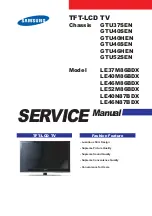
Chronological Effects
False installation or use of the display during operating time may bring forth
undesirable partly visible effects.
The intern structure of imaging part (panel) may be changed by outside
influences with partly visible effects.
)
“Image Sticking”
This phenomenon which named alternatively “image retention”, „ghost image“,
„memory effect“ or “remanent image” and appears if the fluid crystals of the
panel depart from the initial position. This effect may have different causes,
which are not clarified technologically. This undesired effect may occur if same
content are continual showed for months and thereafter the content change.
Then possibly old content are still visible as „shade“. These effects are wear
marks, which may be intensify by unsuitable usage. It is not a defect!
Image Sticking must not confuse with „Burn-in“, which is a known fact of
plasma displays and cathode ray tubes and is based on completely different
physical mechanisms. Heavy „Image Sticking“ may be reversed by long switch
off of the LCD/TFT displays, but they appear later again.
Image Sticking of TFT panels is excluded from the warranty.
)
„Mura“
Further effect is Mura (a Japanese term for unevenness), which is visible as
cloud formation. These clouds are particularly visible at low brightness. The
main reason for the occurrence of Mura is operating the system in wrong
temperature specifications. These may generally be caused by to high ambient
temperature as well as poor air supply caused by wrong installation or
polluted ventilation system.
Mura of TFT panels is excluded from the warranty.
)
Shade formation
Dust particle may build up inside the panel caused by high ambient pollution
level. These particles climb up in the panel. This effect starts mostly in corner
of the rim through the different layers by convention and capillary formation.
These pollutions may be reversed by resolving and cleaning of the panel
components in our clean room.
Shade formation of TFT panels by pollution is excluded from the warranty.
Summary
Unlike permanent burn-in in phosphor-based displays, which is the result of a
premature aging of the phosphors of individual pixels, and thus, is irreversible,
image sticking in LCD panels can often be reversed to a point of total
invisibility.
However, the extent to which image sticking can be reversed depends on the
severity of the causes that eventually led to image retention; top in the list is
the environmental temperature at which image sticking took place.
A way to remove a retained image on an LCD panel is to run an all-white screen
saver for several hours. It would generally help if this image sticking reversal
operation were run at an elevated temperature of around 104° Fahrenheit or
40° Celsius. This should help speed up the reversal process.
Another way could be turning off the LCD display for a longer period than the
time it took for the static image to cause image retention.
As on a desktop monitor it is also possible to use a screen saver. Please
remember the bigger the size of an LCD monitor, the bigger is the danger for
image retention, image sticking or memory effect.
If you don’t use the eyeCON software, please consider the other described
ways to prevent from image sticking.
EYE-LCD-4600/5500-LE-700
57
Version 1.0 | November 2013
Summary of Contents for eyeLCD-4600-LE-700
Page 64: ...EYE LCD 4600 5500 LE 700 64 APPENDIX DIMENSIONS EYE LCD 4600 LE 700 ...
Page 65: ...EYE LCD 4600 5500 LE 700 65 APPENDIX DIMENSIONS EYE LCD 5500 LE 700 ...
Page 69: ...EYE LCD 4600 5500 LE 700 69 Appendix Wall Mount Safety Notes ...
Page 70: ...EYE LCD 4600 5500 LE 700 70 ...
Page 81: ...Notes Notizen ...
















































